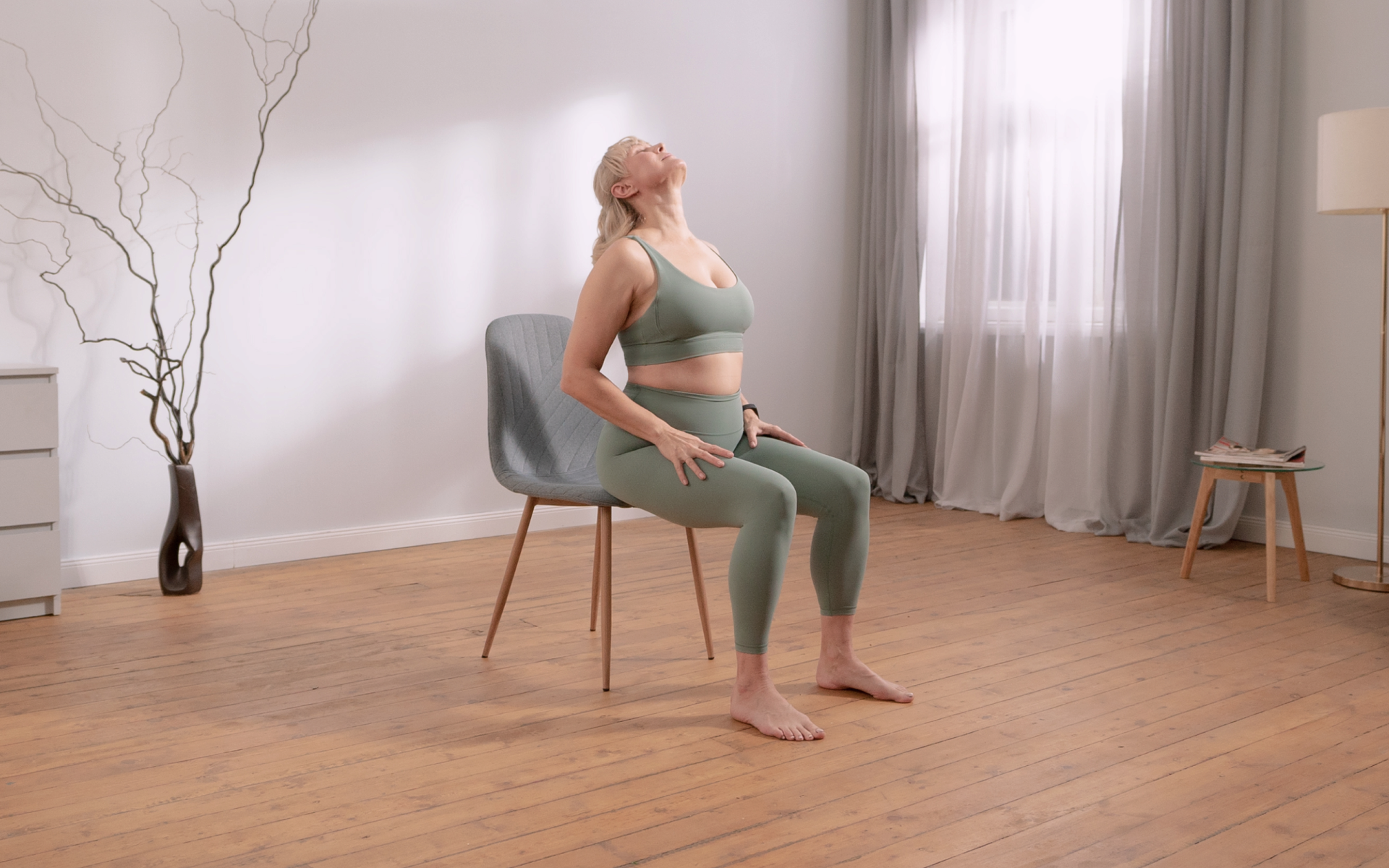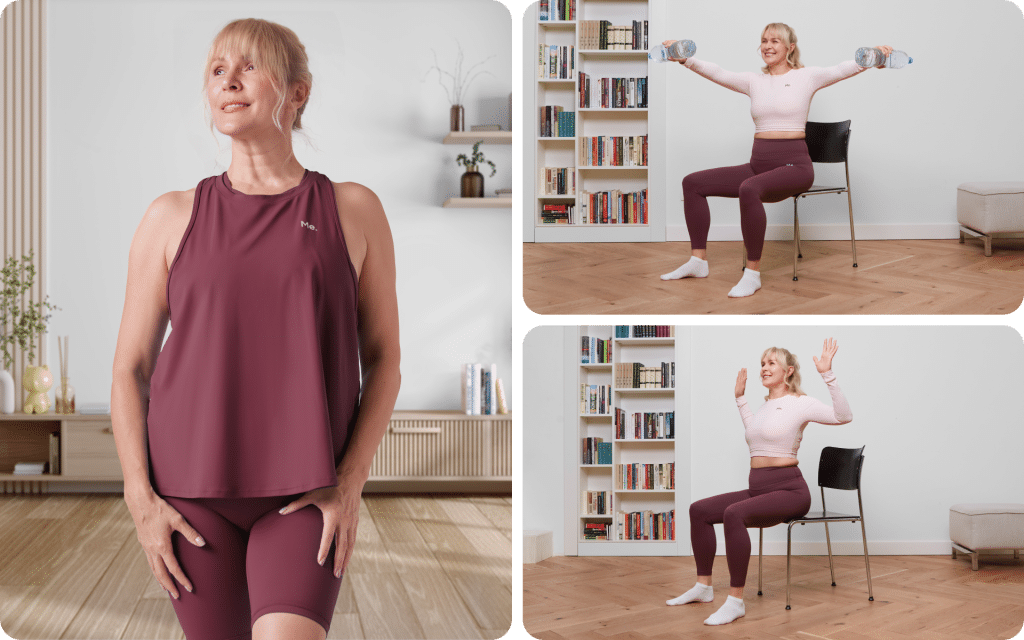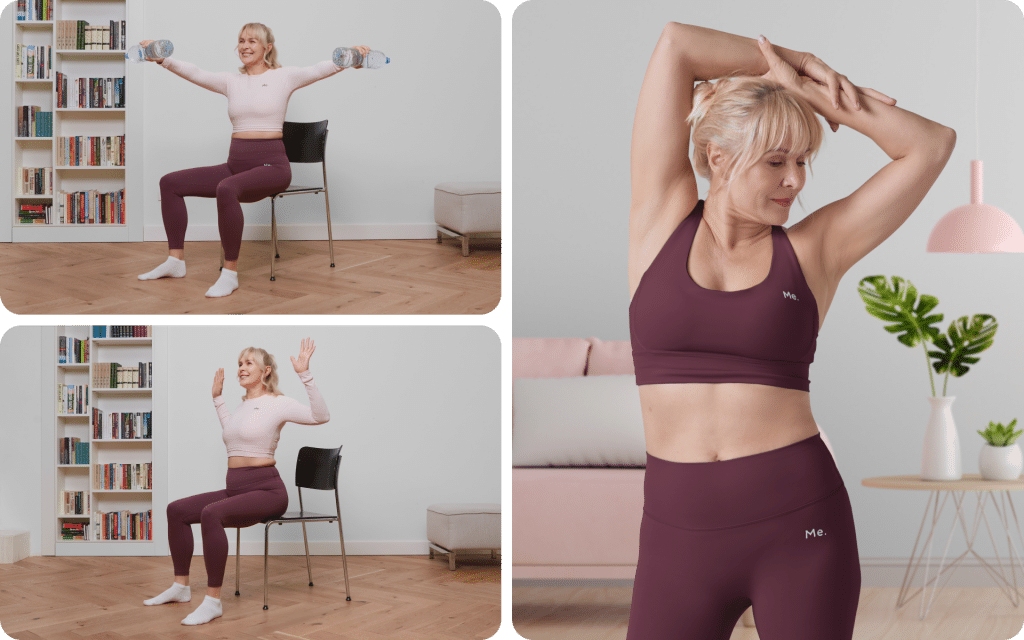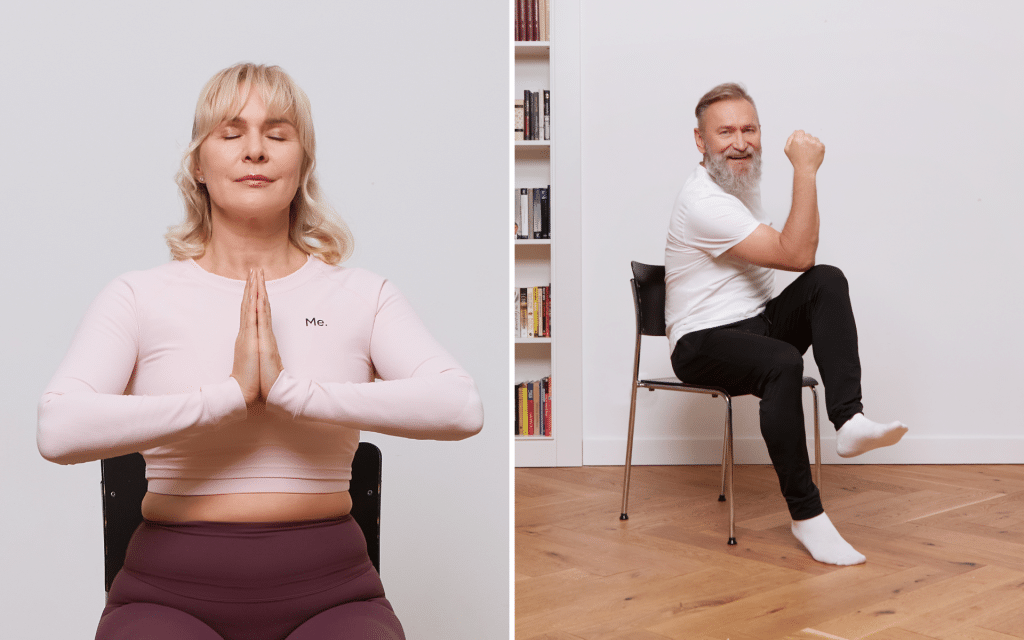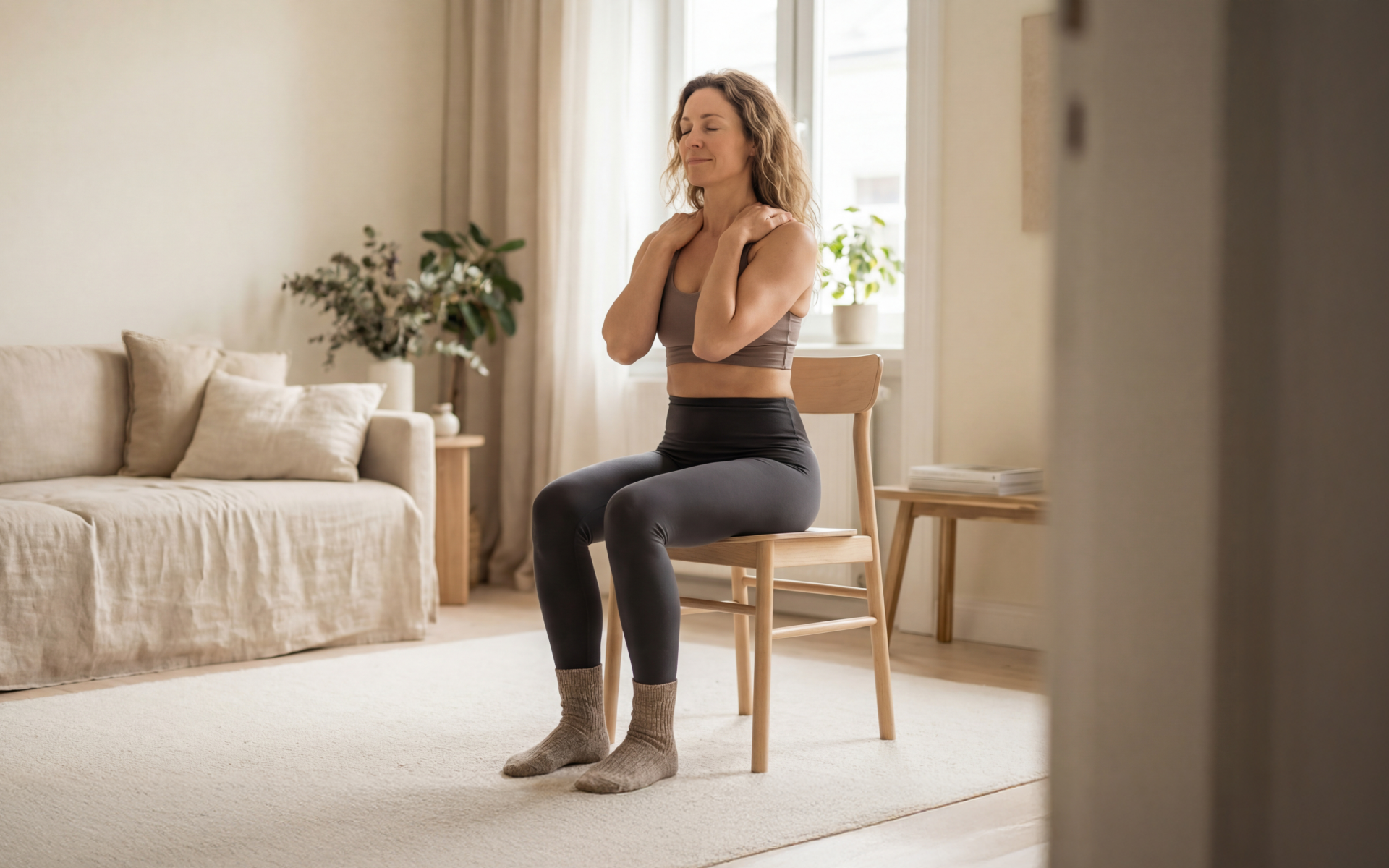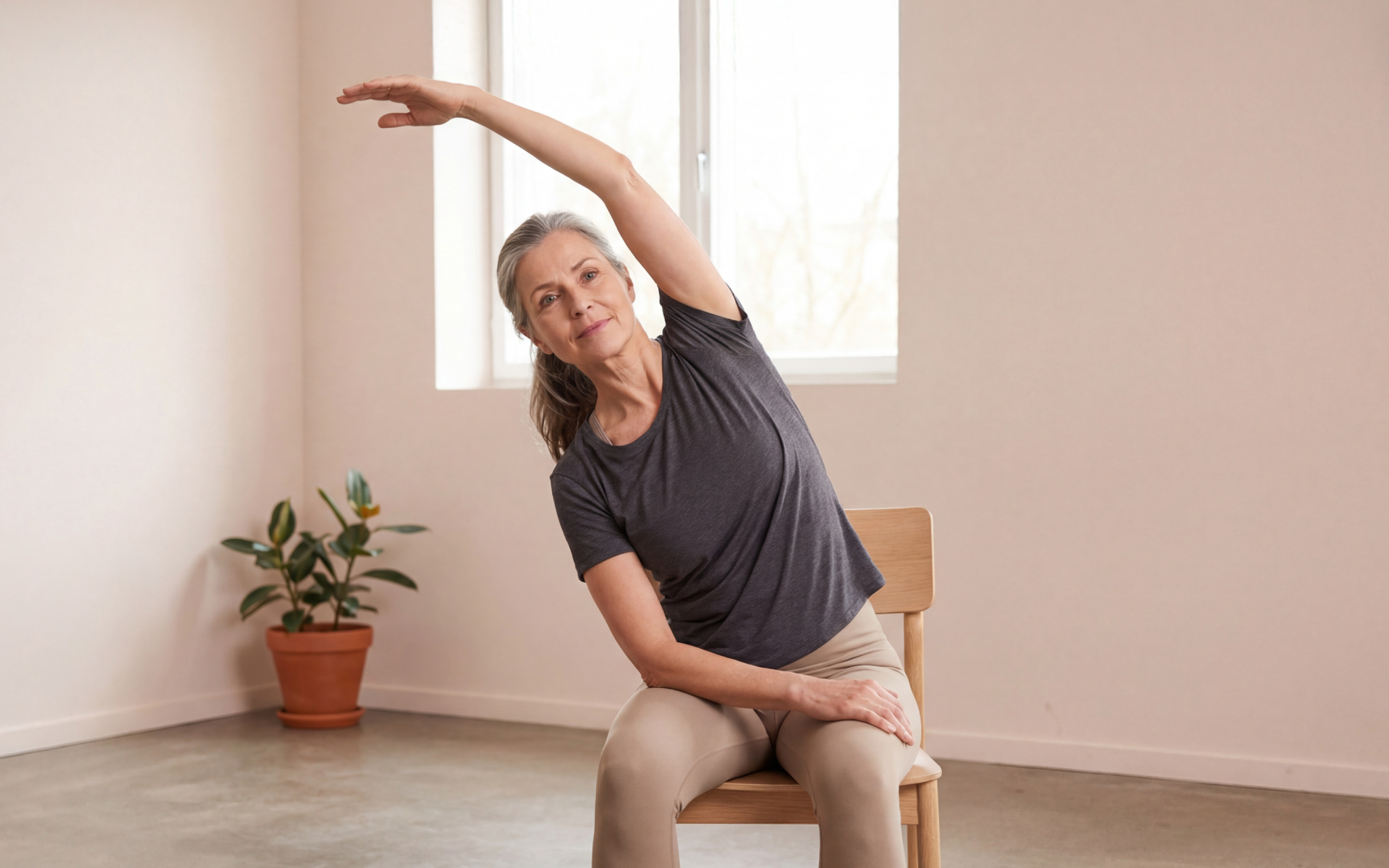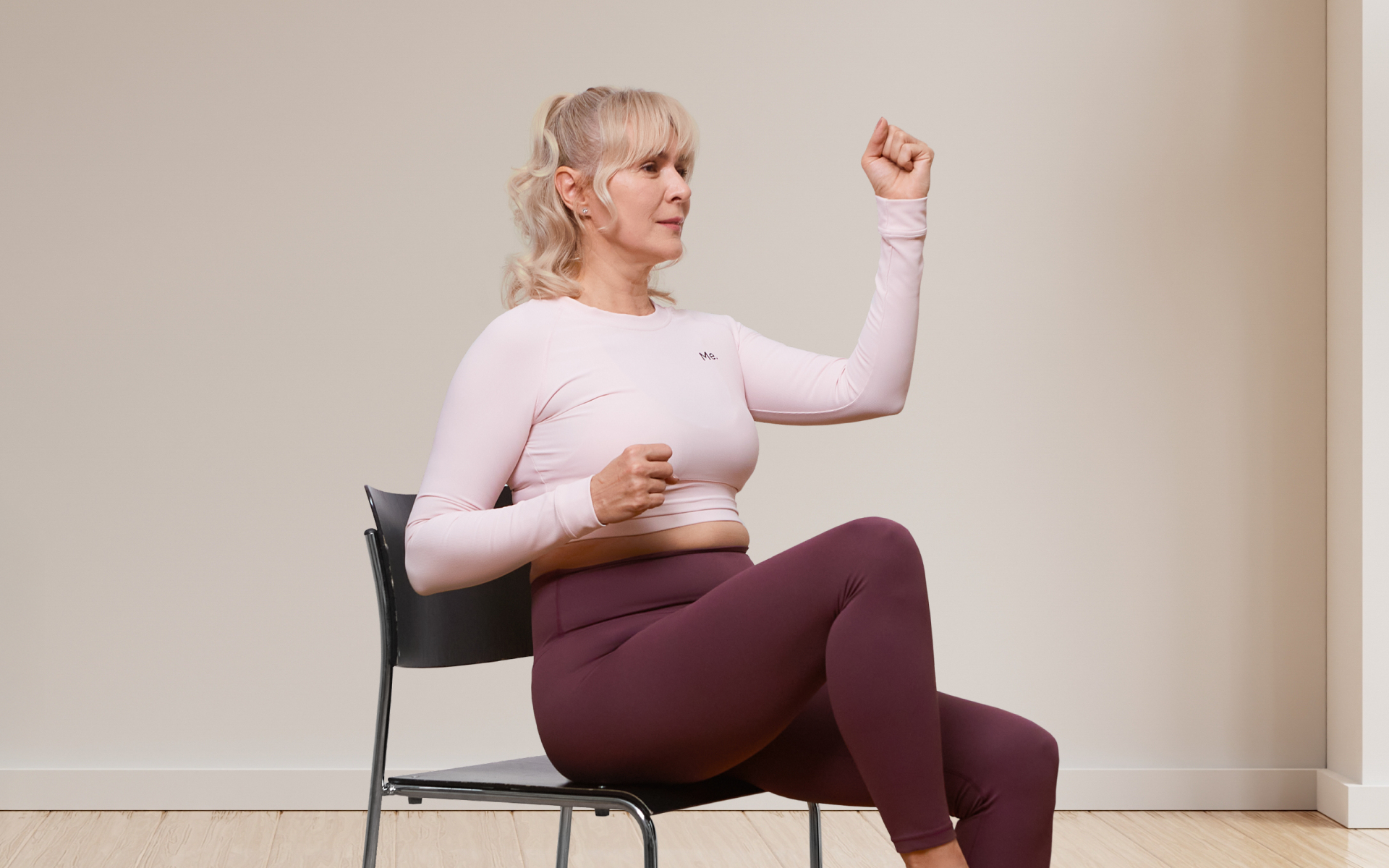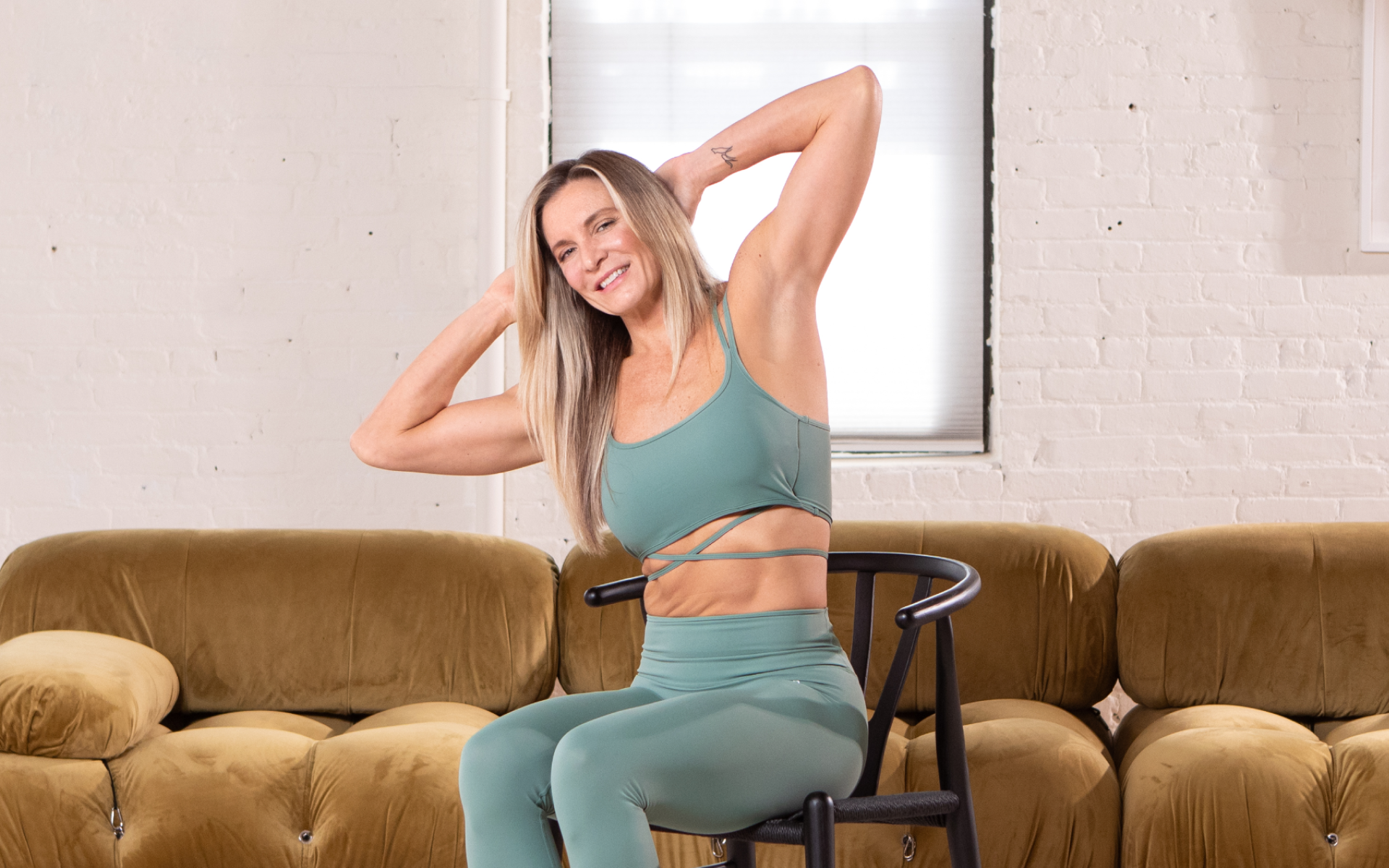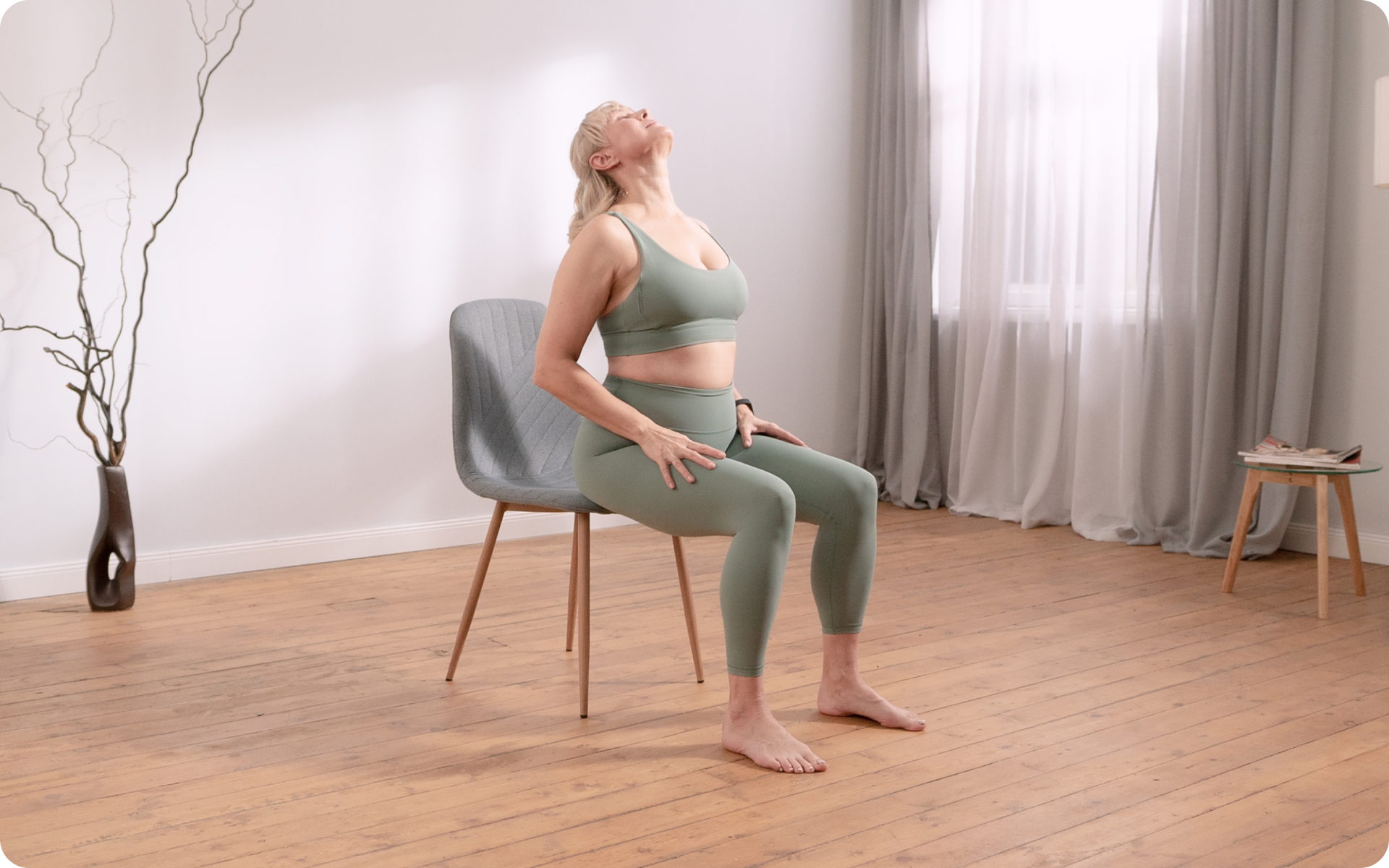Restricted mobility can be a literal pain, preventing you from performing daily activities with ease and comfort. Whether it’s due to chronic pain, injury, or age-related issues, restricted mobility can greatly impact your quality of life.
However, there are ways you can combat this issue and improve your everyday movement. One effective solution is chair yoga.
Chair yoga involves performing traditional yoga poses while seated on a chair or using a chair for support. It offers numerous benefits that can help those with restricted mobility regain strength and flexibility, reduce stress and anxiety levels, improve balance and coordination, and increase overall well-being.
Here, we’ll discuss 7 simple yet effective chair yoga exercises you can incorporate into your daily routine to enhance your everyday movement.
Can You Do Yoga With Restricted Mobility?
Yes, you can perform yoga with restricted mobility provided you get the green light from your doctor.
Using props such as a chair for support and making modifications to traditional poses can make yoga accessible for individuals with limited mobility. Chair yoga also allows for a gentler practice, which makes it safer for those with chronic pain or injuries.
Here are some tips you should keep in mind when practicing chair yoga with restricted mobility:
- Easy Does It
When starting your chair yoga journey, it’s important to take things slowly. Allow your body to adapt to the movements without pushing yourself too hard.
Start with gentle stretches and gradually work your way up to more complex poses as you build strength and flexibility. Listening to your body is key; if something doesn’t feel right, it’s perfectly okay to skip it or modify the practice to suit your comfort level.
- Gear up for Comfort
Comfort should be your top priority when practicing chair yoga, especially for those with restricted mobility. Choose a sturdy chair with good back support and ensure you can sit down and get up from it easily.
It’s also a good idea to wear comfortable clothing that allows for freedom of movement, so you can stretch without feeling restricted.
You may consider using a chair with armrests, as this can provide additional support during certain movements, which makes it easier to build confidence in your practice.
If you start to feel discomfort or strain in any position, don’t hesitate to adjust your posture or take a break.
- Pay Attention to Body Alignment
Maintaining proper body alignment is essential for preventing injuries and ensuring safety during your chair yoga practice. Keep your feet flat on the floor and adjust the height of your chair if necessary to achieve this.
When sitting upright, make sure your shoulders are relaxed and your spine is straight without leaning too far forward or backward.
A consistent awareness of your body’s alignment will help you avoid unnecessary stress on your joints and muscles.
For poses that involve upper-body movement, such as reaching or twisting, keep your core engaged to support your spine and protect your lower back.
- Use Gentle Transitions
Transitioning between poses can sometimes be challenging, particularly for individuals with mobility limitations. Take your time when moving from one position to another and consider using support, such as the arms of your chair, for stability.
Employing gentle transitions helps to prevent any sudden movements that may lead to strain or discomfort.
For example, if you’re moving from a seated twist to a forward fold, do so slowly and with control, pausing momentarily in a neutral position to gauge your body’s response.
This mindful approach enhances safety and enriches your overall experience by allowing you to stay connected to your breath and bodily sensations throughout the practice.
BetterMe: Health Coaching app helps you achieve your body goals with ease and efficiency by helping to choose proper meal plans and effective workouts. Start using our app and you will see good results in a short time.
- Modify as Needed
Chair yoga is all about making the practice your own, so don’t hesitate to modify poses to fit your abilities.
For example, if a forward bend feels challenging, you can simply reach your arms forward instead of bending deeply. If a pose requires standing, you can use the chair for support or remain seated. The goal is to engage with the practice in a way that feels good for you.
- Breathe Mindfully
Breath control plays a crucial role in yoga (1), particularly for those with restricted mobility. Focus on deep, mindful breathing to help relax your muscles and enhance your overall experience.
Inhale deeply through your nose, allowing your abdomen to expand, and exhale slowly through your mouth to release tension. This rhythmic breathing helps with relaxation and helps you stay present and conscious of your movements, which makes the practice more enjoyable.
- Stay Consistent
Consistency is key when it comes to reaping the benefits of chair yoga. Try to practice regularly, even if it’s just for a few minutes each day.
Creating a routine can help you establish familiarity with the exercises and encourage gradual improvement in mobility and strength.
Whether you choose to practice in the morning to kickstart your day or in the evening to unwind, finding a time that works for you can make a significant difference in how you feel both physically and mentally.
Read more: Morning Chair Workout: 8 Exercises You Can Do With or Without Weights
Who Is Chair Yoga Suitable for?
Chair yoga is suitable for:
1. Seniors
Chair yoga is an excellent option for older adults who often face mobility limitations, providing a safe way to improve flexibility, balance, and overall strength while minimizing the risk of falls (2). Depending on individual abilities and limitations, chair yoga can be modified to suit different needs and fitness levels.
2. Individuals with Chronic Pain
For those suffering from conditions such as arthritis or fibromyalgia, chair yoga can gently stretch and strengthen muscles, reducing pain and enhancing comfort (3). However, it’s important to consult your doctor before starting any new exercise routine.
3. People with Disabilities
Chair yoga is particularly beneficial for individuals with physical disabilities as it allows them to engage in movement and exercise at their own pace and ability level (3). Working with a certified chair yoga instructor can help tailor the practice to meet their unique needs.
4. People Recovering from Surgery
Engaging in gentle movements after surgery can help with recovery (4). Chair yoga helps maintain mobility without straining healing tissues. It’s important to consult a doctor or physical therapist before initiating any exercise routine post-surgery.
5. Pregnant Women
Chair yoga provides expecting mothers with a safe way to remain active and maintain muscle strength without adding extra strain to their bodies (5).
They can practice chair yoga to relieve tension, improve circulation, and support overall well-being, especially in the later trimester. However, it’s always advised to consult a healthcare provider before starting any new exercise routine.
6. Office Workers
For those sitting for long hours, chair yoga can help alleviate tension and stiffness, enabling workers to stretch and improve their postural variation during the workday.
This practice is easily accessible and requires minimal time or space, which makes it ideal for those with hectic schedules who still wish to incorporate movement into their daily routine.
7 Chair Yoga Poses for Restricted Mobility
Here are seven simple yet effective chair yoga poses that can help promote flexibility, strength, and relaxation:
Seated Camel Pose (Ustrasana)
Ustrasana stretches the front of your body, including the chest and abdomen, while strengthening your back muscles. For people with limited mobility, this pose can improve posture and relieve lower back pain.
- Sit on the edge of your chair with your feet flat on the ground.
- Place your hands on your hips and inhale deeply.
- Slowly arch your spine backward while keeping your chest lifted and open.
- Hold for a few breaths, then exhale as you come back to a neutral position.
Seated Eagle Pose (Garudasana)
Garudasana helps enhance balance, concentration, and flexibility in the legs and arms while also strengthening muscles in the upper back and shoulders. This pose can be particularly beneficial for individuals with shoulder or neck tension.
- Start seated sideways on your chair with your feet flat on the floor.
- Cross your right leg over your left thigh, and wrap your left arm under your right.
- Bring your forearms together in front of you, then bend your elbows to bring both palms together.
- Hold for a few breaths, then release and repeat on the opposite side.
Seated Cat-Cow Pose
This gentle sequence helps improve spinal mobility while stretching the spine and torso muscles.
- Sit tall with both feet firmly planted on the ground.
- Place one hand on each knee and inhale deeply as you arch your back into a seated cow pose.
- On the exhale, round out your back and bring your chin to your chest in a seated cat pose.
- Repeat this sequence for several breaths, moving with your breath.
Seated Forward Bend (Paschimottanasana)
This pose stretches the hamstrings, lower back, and spine while also calming the mind and relieving stress.
- Start by sitting tall on the edge of your chair with your feet flat on the ground.
- Inhale deeply as you lengthen your spine, then exhale as you hinge forward at the hips, keeping your back straight.
- Reach toward or past your toes as far as comfortable.
- Hold for a few breaths before slowly releasing and returning to an upright position.
Seated Twist (Ardha Matsyendrasana)
This pose can help relieve tension in the back and hips, promote spine health, and help with digestion.
- Start by sitting sideways on your chair with your feet flat on the ground.
- Place one hand behind you on the seat of the chair to support yourself and bring your opposite arm across your body onto your outer thigh or knee.
- Inhale deeply as you lengthen your spine, then exhale as you gently twist from the core to look over your shoulder.
- Hold for a few breaths before releasing and repeating on the opposite side.
Reasons why BetterMe is a safe bet: a wide range of calorie-blasting workouts, finger-licking recipes, 24/7 support, challenges that’ll keep you on your best game, and that just scratches the surface! Start using our app and watch the magic happen.
Seated Warrior II (Virabhadrasana II)
This variation of the traditional Warrior II pose helps strengthen the legs and open up the hips, while also promoting concentration and balance.
- Start seated with your feet flat on the floor and your arms by your sides.
- Step one foot forward, keeping it in line with your knee, and extend the other leg straight back behind you.
- Raise both arms parallel to the ground, palms facing down.
- Hold for a few breaths before releasing and switching sides.
Seated Pigeon Pose (Eka Pada Rajakapotasana)
This pose can help stretch tight hip muscles while also helping with relaxation and stress relief.
- Start seated with both feet planted on the ground.
- Lift one foot and place your ankle on top of your opposite thigh, forming a figure four shape with your legs.
- Inhale deeply as you lengthen your spine, then exhale as you gently hinge forward at the hips.
- Hold for a few breaths before slowly releasing and repeating on the opposite side.
Is Chair Yoga Difficult?
The degree of difficulty in chair yoga can vary depending on individual abilities and the level of challenge incorporated into each exercise. Some poses may be more challenging for some individuals, while others may find them easier.
However, compared to traditional yoga practiced on a mat, chair yoga is generally considered to be less physically demanding. It can be adapted to suit different fitness levels and limitations, making it accessible for individuals of all ages and abilities.
Consistent practice can also help improve mobility, strength, and flexibility over time, which makes poses that were once difficult easier to perform.
Working with a certified chair yoga instructor can also help tailor the practice to an individual’s specific needs and abilities.
What Are the 5 Benefits of Chair Yoga for Restricted Mobility?
Chair yoga offers a wide range of physical, mental, and emotional benefits:
Improved Flexibility
Chair yoga can significantly enhance flexibility, a fundamental aspect of physical health that can decline with age or inactivity. Through regularly practicing chair yoga, individuals engage in a series of gentle stretches that target major muscle groups.
Research has indicated that consistent stretching can lead to increased flexibility and range of motion, which is important for daily activities and overall quality of life (6).
The low-impact nature of chair yoga makes it accessible, allowing individuals to gradually ease into deeper stretches without the risks associated with more intense forms of exercise.
Increased Strength
While chair yoga may appear gentle, it can effectively build muscle strength and endurance through bodyweight resistance and controlled movements. Strengthening exercises that are focused on the core, legs, and arms contribute to better support for joints and help reduce the risk of falls and injuries.
A study published in the Journal of Physical Activity & Health found that older adults who engaged in strength-training exercises, including yoga, demonstrated significant improvements in muscle strength and functional performance (7).
This foundational strength enhances functional mobility, empowering individuals to perform everyday tasks with greater ease.
Enhanced Balance
Balance is an essential component of physical fitness, particularly for older adults and individuals with mobility restrictions.
Chair yoga incorporates movements that promote stability and coordination, allowing practitioners to develop their balance in a safe environment.
According to research in the Journal of Aging and Physical Activity, regular engagement in balance-focused exercises, such as those found in yoga, can result in significant improvements in postural stability(8).
Improved balance not only supports independence but also plays a crucial role in fall prevention, which is especially important for those at risk of falling.
Stress Reduction
The mindfulness and breathing techniques that are central to chair yoga provide potent tools for stress management. Engaging in deep breathing exercises activates the parasympathetic nervous system, which helps calm the body and reduce the levels of stress hormones such as cortisol.
A meta-analysis published in JAMA Internal Medicine found that mindfulness practices, including yoga, can be effective in reducing anxiety and depression (9). The focus on the present moment, combined with gentle movements, allows individuals to release tension and promote emotional balance.
Improved Sleep Quality
The integration of mindful movement and relaxation techniques in chair yoga can positively impact sleep quality. Research has shown that regular physical activity, including yoga, correlates with improved sleep patterns and overall sleep quality (10).
By practicing chair yoga, individuals may find it easier to drift off to sleep, enjoy deeper sleep cycles, and reduce instances of insomnia. The combination of physical relaxation and mental decompression created through chair yoga sets the stage for restorative sleep, ultimately enhancing daytime function and overall well-being.
Read more: Chair Yoga for Men Over 50: 10 Gentle Exercises to Improve Flexibility and Strength
Is it OK to Do Chair Yoga Every Day?
Because chair yoga is low-impact and adaptable, it can be a great way to incorporate gentle movement into daily routines without putting strain on the body. So, most individuals can safely practice chair yoga every day, particularly if they are limited by mobility or other health concerns.
However, it’s essential to listen to your body and not push beyond your comfortable limits. If you experience any discomfort or pain during a chair yoga session, you should stop and consult a healthcare professional before continuing.
Furthermore, as with any form of exercise, consistency is key. Regularly practicing chair yoga will yield the most significant benefits in terms of flexibility, strength, balance, and stress reduction.
It’s also important to note that chair yoga can be modified to fit different schedules and needs; even a short 10-minute session can bring positive effects.
We’ve discussed an optimized chair yoga routine in our Chair Yoga Sequences blog.
Chair yoga has been proven to have significant success in various studies, particularly for older adults and individuals with limited mobility. Participants have reported improvements in flexibility, strength, balance, and overall well-being. Many practitioners also find chair yoga provides a manageable way to engage in physical activity, which leads to greater consistency and adherence to exercise routines. Yes, chair yoga is effective in improving balance. The incorporation of movements that are focused on stability and coordination helps individuals develop a better sense of balance in a safe environment. Regular practice can lead to substantial gains in postural stability, which is important for preventing falls, especially among older adults. These Chair Exercises For Seniors are tailored for the older population as they’re low-impact and easy to perform. Chair yoga is worth it for many individuals, particularly those who are looking for a low-impact exercise option. The benefits include enhanced flexibility, strength, balance, stress reduction, and improved sleep quality. It also offers an accessible way for those with mobility challenges to engage in physical activity and promote overall health. Absolutely. Chair yoga is designed to be inclusive and adaptable, which makes it an excellent choice for people with physical disabilities. The modifications and seated exercises allow individuals to participate at their own pace and comfort level, fostering a sense of accomplishment and well-being. Yes, individuals who consider themselves inflexible can certainly practice chair yoga. The gentle movements and emphasis on gradual progression make it ideal for those who are looking to improve flexibility without the need for advanced poses. With consistent practice, even those who are inflexible can experience an increased range of motion. Definitely. Chair yoga is suitable for unfit individuals. Its low-impact nature and the ability to modify poses make it an accessible form of exercise that can help build strength, flexibility, and confidence. Beginners can start with basic movements and gradually progress as their fitness levels improve. This 28-Day Chair Yoga For Seniors is low-impact and perfect for seniors and beginners alike. While most people can safely practice yoga, certain conditions may warrant caution. Individuals with severe osteoporosis, advanced heart conditions, or those who are recovering from recent surgery should consult a healthcare professional before engaging in yoga. Always listening to your body and avoiding movements that cause pain or discomfort is important, regardless of the practice.Frequently Asked Questions
How successful is chair yoga?
Does chair yoga help with balance?
Is chair yoga worth it?
Can people with physical disabilities do yoga?
Can an inflexible person do yoga?
Can unfit people do yoga?
Who should not do yoga exercises?
The Bottom Line
Chair yoga for restricted mobility individuals is an accessible and effective way to improve physical and mental well-being. Its low-impact nature, combined with its focus on mindful movement and relaxation techniques, makes it suitable for people of all ages and abilities.
With consistent practice, chair yoga can lead to increased flexibility, strength, balance, stress reduction, and improved sleep quality. Consulting a healthcare professional and listening to your body’s limits are essential for safely incorporating chair yoga into your daily routine.
DISCLAIMER:
This article is intended for general informational purposes only and does not serve to address individual circumstances. It is not a substitute for professional advice or help and should not be relied on for making any kind of decision-making. Any action taken as a direct or indirect result of the information in this article is entirely at your own risk and is your sole responsibility.
BetterMe, its content staff, and its medical advisors accept no responsibility for inaccuracies, errors, misstatements, inconsistencies, or omissions and specifically disclaim any liability, loss or risk, personal, professional or otherwise, which may be incurred as a consequence, directly or indirectly, of the use and/or application of any content.
You should always seek the advice of your physician or other qualified health provider with any questions you may have regarding a medical condition or your specific situation. Never disregard professional medical advice or delay seeking it because of BetterMe content. If you suspect or think you may have a medical emergency, call your doctor.
SOURCES:
- Effects of yogic breath regulation: A narrative review of scientific evidence (2019,nih.gov)
- Safety and feasibility of modified chair-yoga on functional outcome among elderly at risk for falls (2012,nih.gov)
- Effect of Chair Yoga Therapy on Functional Fitness and Daily Life Activities among Older Female Adults with Knee Osteoarthritis in Taiwan: A Quasi-Experimental Study (2023,nih.gov)
- Merits of exercise therapy before and after major surgery (2014,nih.gov)
- Systematic Review of Yoga for Pregnant Women: Current Status and Future Directions (2012,nih.gov)
- The benefits of static stretching on health: a systematic review (2024,jkes.eu)
- Exercise interventions for older adults: A systematic review of meta-analyses (2021,nih.gov)
- Effect of Yoga on Balance in Geriatric Population (2019,researchgate.net)
- Meditation Programs for Psychological Stress and Well-being (2014,jamanetwork.com)
- The Effect of Physical Activity on Sleep Quality and Sleep Disorder: A Systematic Review (2023,nih.gov)
